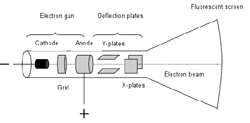Introduction of CRO (cathode ray oscilloscope)
The most versatile tool which can be used for the development of electronic circuits and systems is the Cathode ray oscilloscope. It allows the amplitude of electrical signals, whether they are voltage, current or power, to be displayed as a function of time.
The galvanometer and other mechanical device have existed for along time. but their major limitation is slow response. Oscilloscopes are capable of giving a faster response to these mechanical devices.
In 1879,William crookes demonstrated that the cathode rays can be deflected in a vacuum tube by using a magnet. the combination of focusing elements were used to produce a narrow electron beam called as cathode ray aimed at fluorescent target. The combination of all these elements formed a tube known as crooks tube. It was later called as cathode ray tube an electron beam tube.
The CRO has Stylus (i.e., a luminous spot) which move over the display area in response to an input voltage. This luminous spot is produced by a beam of electrons striking on a fluorescent screen. The normal form of the CRO uses a horizontal input voltage which is an internally generated ramp voltage called “time base”.


